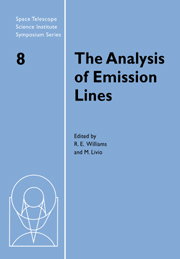Book contents
- Frontmatter
- Contents
- Participants
- Preface
- Emission Lines: Past and Future
- Atomic Data for the Analysis of Emission Lines
- Radiative Transfer
- Emission Lines from Winds
- Photoionizing Shocks
- The Lexington Benchmarks for Numerical Simulations of Nebulae
- Emission Line Diagnostics
- Ultraviolet Spectroscopy
- Infrared Emission Lines as Probes of Gaseous Nebulae
- Molecular Emission Line Diagnostics in Astrophysical Environments
- Abundance Determinations
- Astrophysical Gamma Ray Emission Lines
- Summary Remarks
Preface
Published online by Cambridge University Press: 23 November 2009
- Frontmatter
- Contents
- Participants
- Preface
- Emission Lines: Past and Future
- Atomic Data for the Analysis of Emission Lines
- Radiative Transfer
- Emission Lines from Winds
- Photoionizing Shocks
- The Lexington Benchmarks for Numerical Simulations of Nebulae
- Emission Line Diagnostics
- Ultraviolet Spectroscopy
- Infrared Emission Lines as Probes of Gaseous Nebulae
- Molecular Emission Line Diagnostics in Astrophysical Environments
- Abundance Determinations
- Astrophysical Gamma Ray Emission Lines
- Summary Remarks
Summary
Apart from stars and those objects which radiate reflected starlight, most of the objects in the Universe radiate an emission spectrum. It was the astronomers interest in analyzing the spectrum of the sun and other stars in the last century that motivated the development of radiative transfer, and with the newly formulated macroscopic relations of LTE early in this century, that led to our understanding of absorption spectra. The original observational stimulus for this activity had been Fraunhofer's study of the solar spectrum almost a century before.
Interest in emission-line spectra came later, when spectrographs coupled to telescopes enabled the spectra of fainter gaseous emission regions to be observed. They revealed a totally different type of spectrum than that which had been observed from stars. The fact that local thermodynamic equilibrium does not hold for emission regions has complicated the interpretation of their spectra. Huggins' initial discovery of ‘nebulium’ in gaseous nebulae and its subsequent identification with ionized oxygen by Bowen had demonstrated that rarefied conditions must pertain in nebulae. Stromgren's subsequent 1939 paper in the Astrophysical Journal was a landmark in demonstrating how far-UV continuum radiation from a hot star was absorbed by surrounding gas and converted into visible Balmer line radiation.
In the decades that followed, the realization that many interesting objects such as supernova remnants, active galactic nuclei, and quasars radiated an emission-line spectrum, motivated the analysis of emission regions.
- Type
- Chapter
- Information
- The Analysis of Emission Lines , pp. xi - xiiPublisher: Cambridge University PressPrint publication year: 1995



